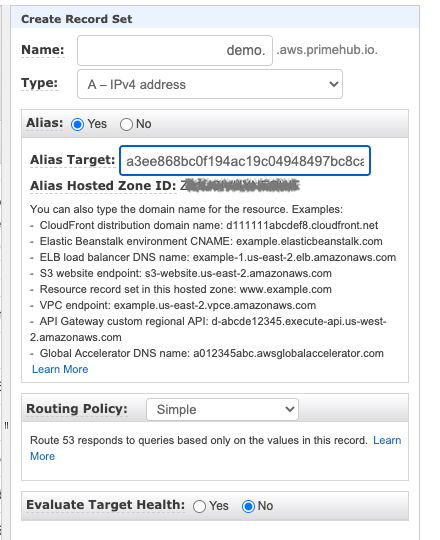Kubernetes on AWS EKS
This document guides you to deploy a Kubernetes on AWS EKS for PrimeHub.
Prepare
You must have a valid AWS account with proper permissions to continue this guide.
Generate Access Key
Visiting AWS Console and IAM service page to generate your own access key.
Prepare AWS credentials
mkdir -p ~/.aws
touch ~/.aws/credentials
Edit credentials and add the content with the generated access key.
# credentials
[default]
aws_access_key_id = xxx
aws_secret_access_key = xxx
region = ap-northeast-1
Install aws-cli and eksctl on your working machine
# Install awscli
brew install awscli
# Install eksctl
brew tap weaveworks/tap
brew install weaveworks/tap/eksctl
eksctl version
Prepare a Domain name
Prepare your domain name and manage it by Route53; Please see Making Route 53 the DNS service for a domain that's in use for details.
Create EKS Kubernetes Cluster
Create EKS cluster by eksctl command with a proper __my_cluster_name__.
# Prepare customized data
EKS_CLUSTER_NAME=__my_cluster_name__
EKS_REGION=ap-northeast-1
EKS_ZONE=${EKS_REGION}-c
# Running eksctl to create EKS cluster
eksctl create cluster -f - <<EOF
apiVersion: eksctl.io/v1alpha5
kind: ClusterConfig
metadata:
# this is the name of the cluster
name: ${EKS_CLUSTER_NAME}
region: ${EKS_REGION}
version: "1.15"
vpc:
nat:
gateway: Disable
nodeGroups:
- name: default-node-group
instanceType: m5.large
desiredCapacity: 2
labels:
component: singleuser-server
iam:
withAddonPolicies:
externalDNS: true
availabilityZones: ["${EKS_ZONE}"]
EOF
Wait until EKS cluster is created, then check the cluster.
eksctl get cluster
Update kube-config with the newly created cluster info.
aws eks update-kubeconfig --name ${EKS_CLUSTER_NAME} --alias ${EKS_CLUSTER_NAME}
Try to get nodes to verify the added kubeconfig:
kubectl get nodes
NAME STATUS ROLES AGE VERSION
ip-192-168-2-53.ap-northeast-1.compute.internal Ready <none> 21s v1.15.10-eks-bac369
ip-192-168-74-187.ap-northeast-1.compute.internal Ready <none> 21s v1.15.10-eks-bac369
Install helm
Install helm 2.x binary. Please see the installation steps in prerequisites. Make sure the helm binary version is v2.x.x (v3.x.x is not supported yet)
helm version --client
Client: &version.Version{SemVer:"v2.16.3", GitCommit:"1ee0254c86d4ed6887327dabed7aa7da29d7eb0d", GitTreeState:"clean"}
Apply RBAC resources for helm
kubectl apply -f - << EOF
apiVersion: v1
kind: ServiceAccount
metadata:
name: tiller
namespace: kube-system
---
apiVersion: rbac.authorization.k8s.io/v1
kind: ClusterRoleBinding
metadata:
name: tiller
roleRef:
apiGroup: rbac.authorization.k8s.io
kind: ClusterRole
name: cluster-admin
subjects:
- kind: ServiceAccount
name: tiller
namespace: kube-system
EOF
Nginx Ingress
helm install stable/nginx-ingress --namespace ingress-nginx --name nginx-ingress --set rbac.create=true
Find the EXTERNAL-IP
kubectl get svc -n ingress-nginx
NAME TYPE CLUSTER-IP EXTERNAL-IP PORT(S) AGE
nginx-ingress-controller LoadBalancer 10.100.253.162 a3ee868bc0f194ac19c04948497bc8ca-a179fb405d10a39f.elb.ap-northeast-1.amazonaws.com 80:31938/TCP,443:30853/TCP 21d
nginx-ingress-controller-metrics ClusterIP 10.100.146.39 <none> 9913/TCP 21d
nginx-ingress-default-backend ClusterIP 10.100.49.194 <none> 80/TCP 21d
Go to AWS web console Route53 page and add a Type A record for your domain with alias name.

Quick Verification
Query nginx-ingress with your own domain:
curl http://<your-own-domain>
The output will be 404, because nobody defines any Ingress resources:
default backend - 404
Next - Setup PrimeHub
Now a kubernetes-ready EKS is ready for PrimeHub installation. Next, go to Setup PrimeHub section.